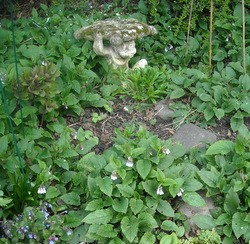Grow Comfrey to give your garden a real lift year after year
Posted by Fiona Nevile in Vegetables | 11 comments
A few years I wrote about rocambole and a few weeks later I discovered that it was actually growing in my garden. A colleague in London had given it to me on a plant swap and described it as
“White bells that smell of garlic. Weird!”
I felt such a fool.
I’ve had a longing to grow comfrey in my garden as it appears to be such a useful plant. The leaves can be made into a fertilising tea – high in potash, nitrogen and loads of other trace elements that the exuberant roots find deep down in the soil. This tea is a wonderful free fertiliser for fruit bushes, flowers, tomatoes and peppers. Potatoes love comfrey tree too. The leaves can also be used as a mulch. Growmore eat your heart out.
Comfrey relishes a shady spot so would be perfect for the north borders of the garden. I bought a plant a couple of years ago but it fizzled out I stupidly planted it in the wrong place. It hates sun and I hadn’t done my research. So this year I ordered comfrey seeds from the new Otter Farm Shop and hopefully they will be germinating in the Solar Tunnel as my fingers fly across the keyboard.
I’ve just checked and the seeds haven’t germinated yet. They were rock hard so perhaps a warm water soak might be the answer?
A couple of days ago I went up to have a cup of tea at The Chicken Lady’s and look at their superb garden. Surrounded by a lot of trees it’s a difficult patch but both TCL and S have worked wonders. It’s lovely – even now it’s bursting with life. Further up the hill than us, the fruit trees are already in blossom. The earth is different to – good loam, slightly sandier than ours and not all our stones. I must admit that I was a bit envious.
TCL had invested in one of those wonderful dustbin incinerators. I’ve had one for 20 years and finally the bottom fell out of mine last year. But theirs was shiny and new and it didn’t cost much more than the price I paid all those years ago. As she fed the beast we were chatting.
“Nothing much grows on this bank. Just this bit of comfrey and a few other things.”
My ears immediately clicked into intensive listening mode. Comfrey – I need to grow this and use this on our plot. I looked at the comfrey and secretly thought, “That’s not comfrey. It’s pulmonaria.”
Later after tea (not comfrey), S pointed out another large patch of ‘comfrey’.
“But surely that’s pulmonaria. We have loads of that, I’m constantly pulling it out. We have a spotted version too. I love the spotty one – white, pink and blue flowers on the same plant. Magic.”
They tactfully led me to a patch of pulmonaria.
“It is different. Now I look closer.”
It was completely different. But I had assumed it was the same. Assumptions are so often a rocky road of destruction for me.
But I didn’t feel foolish this time. I was elated – we are growing comfrey already. OK its creeping comfrey not the 3’-4’ kind but I hoped that it will do the same job. I pulled all the plants that I’d dug up yesterday out of the compost heap and put them in a large airtight container with some water.
I finally discovered that my low growing comfrey is not the type recommended for homegrown fertiliser. This is called Symphytum x uplandicum or if you want to get onto first name terms – Bocking 14. It is generally sold as root cuttings and is so high in nutrients that it’s also used as an animal feed in Africa and other parts of the world.
To make comfrey tea. Find a bucket with an airtight lid, with comfrey leaves. Cover with water and mature for 4-5 weeks and then be diluted 1:15. Potent stuff. Apparently this mix does small BAD – like sewage apparently. So if your nose buds are sensitive, help is at hand as I found this excellent video. How to make fresh comfrey tea using your liquidiser (don’t tell Danny – he’d never eat soup again).
Meanwhile I’m looking for Bocking 14 roots and think that I’ve found them in Anglesea.
Leave a reply







Hmmm, thanks Fiona, interesting stuff about the comfrey.
I was thinking of creating feed with seaweed, but just this weekend I cleared a shady patch in my garden that would be good for some comfrey.
The Bocking 14 stuff sounds just the job. Will try and find myself some.
A space-saving way of making liquid comfrey feed (much less smelly too): find a large empty plastic bottle (I use those 5L water bottles – they last at least 5 years). Slice off the base about 2 inches from the bottom. Invert and tightly pack the bottle with comfrey leaves. The base that you’ve just cut off will become a lid, but turn it over so you can jam it tightly into the bottle. Keep it in a warm place, screw-top side down. After about 6 weeks the comfrey will have decomposed a good deal. Add more comfrey, packing it tightly. I usually refill the bottle several times in the season. You end up with thick blackish liquid – undiluted essence of comfrey! – which is much less smelly than when it’s been diluted. You will need to dilute it with a lot of water.
By the way I grow comfrey in full sun without problems, but that’s in the north of England. It grows to about 1m and I usually get about 3 cuts a year for compost, feeding hens, and for making liquid feed.
Just be aware that comfrey is a jolly,hardy,rumbustuous thug, if it is happy it will take over your garden… so plant and treat accordingly.
Now I’m confused!
I removed masses of the cream flowered Creeping Comfrey Symphytum ibericum from our borders when we first moved here. In hindsight I realize it smothered the ground elder!
We have white flowered comfrey which self seeds around the garden – and I thought this was the same as the sort used for liquid fertilizer but with white instead of blue/mauve flowers.
Now I’m not sure as I think the white flowered variety is Symphytum orientale and the native purple one Symphytum officinale.
Both slightly different from Russian Comfrey Symphytum uplandicum of which Bocking 14 is a non-fertile sport.
So can I make liquid fertilizer from the White Comfrey in our garden?
Celia
I have just managed to get some bocking 14 root cuttings for a couple for quid on ebay. Glad that you mentioned that they don’t like sun, the place I had picked out for them is way too sunny, I’ll need to find another place.
I salute you if you wait three years to eat your asparagus. Did you plant crowns?
I read some studies that compared asparagus plant health if harvested after one year (crowns) and after three years, and the studies determined no difference in plant health.
Nettles are good for the same thing. I actually planted both comfrey and nettles for making fertilizer, and borage for the bees last week. I haven’t had a chance to go see if anything is coming up.
According to the book I just reviewed, Bocking 14 is especially good because it produces sterile flowers, so no seeds. She did mention that comfrey propagates by roots, and that it’s so sturdy it will withstand four harvests a year. Just quit doing it in September so that it has a chance to recover before winter.
She also mentioned that it’s good for topical use, and that it used to be recommended as a medicinal tea, but they discourage that now because it’s been found to contain alkaloids, which are carcinogens. But I’m not planning on drinking the tea- I want it for the garden!
hey fn
i’ve found somebody off freegle who kindly gave me a couple of cuttings earlier in the year for my lottie. if you don’t mind waiting till the autumn, i can send some to you if you like. i found that Bocking 14 was quite expensive for a couple of roots, so I managed to find someone local who’s into organic growing.
xx bren
Have you any allotments near you? Most allotmenteers will have a patch of comfrey, it does tend to spread so I would think they would be more than happy to dig you up a little piece.
I have a bucket with a built-in tap and lid that I got from Oxfam which is FABULOUS for making nettle and comfrey tea. But it absolutely, completely and utterly STINKS TO HIGH HEAVEN… wear nose plugs if you have to use it fresh in an enclosed space!!!
We have a little comfrey patch, but the chickens have thus far prevented it from spreading. They love the stuff.
Sigh. Good fences make good chickens.